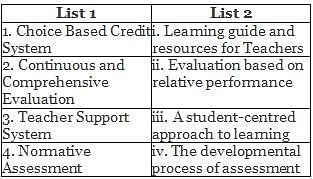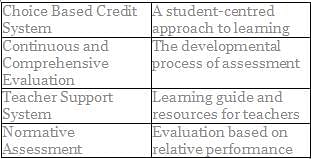UGC NET Paper 1 Practice Test - 1 - UGC NET MCQ
30 Questions MCQ Test UGC NET Mock Test Series 2024 - UGC NET Paper 1 Practice Test - 1
Research has shown that the most frequent symptom of nervous instability among teachers is
Which of the following is not true about research ethics?
i. It relates to the accuracy of results
ii. It relates to proving one’s opinion
iii. It relates to using scientific methods
iv. It relates to keeping the anonymity of the respondents
v. It relates to adhering to the propaganda of political parties
i. It relates to the accuracy of results
ii. It relates to proving one’s opinion
iii. It relates to using scientific methods
iv. It relates to keeping the anonymity of the respondents
v. It relates to adhering to the propaganda of political parties
| 1 Crore+ students have signed up on EduRev. Have you? Download the App |
Which of the following is/are not a source of data?
A lecture without feedback from the students is ______.
Which of the following are the most important qualities of a good teacher?
For an efficient and durable learning, the learner should have
Assertion (A): Human communication involves a set of a procedure through which the information is passed among the people by means of previously agreed symbols, in order to produce the desired response’.
Reason (R): S-M-C-R Model that stands for Smarter-Message-Channel-Receiver. It is the basic communication process.
Which of the following is more interactive and student centric?
Given below are two statements
Statement I: A two‐way communication takes place when the encoding and decoding are in operation with equal frequency by two or more individuals.
Statement II: The communicator and the communicatee are related by the communication circuits and the success of communication depends upon the level of reciprocity between them.
In light of the above statements, choose the most appropriate answer from the options given below
Directions: Read the following passage carefully and answer the question.
The Taj Mahal has become one of the world’s best known monuments. This domed white marble structure is situated on a high plinth at the southern end of a four-quartered garden, evoking the gardens of paradise, enclosed within walls measuring 305 metres by 549 metres. Outside the walls, in an area known as Mumtazabad, were living quarters for attendants, markets, sarais and other structures built by local merchants and nobles. The tomb complex and the other imperial structures of Mumtazabad were maintained by the income of thirty villages given specifically for the tomb’s support. The name Taj Mahal is unknown in Mughal chronicles, but it is used by contemporary Europeans in India, suggesting that this was the tomb’s popular name. In contemporary texts, it is generally called simply the Illuminated Tomb (Rauza-i-Munavvara).
Mumtaz Mahal died shortly after delivering her fourteenth child in 1631. The Mughal court was then residing in Burhanpur. Her remains were temporarily buried by the grief-stricken emperor in a spacious garden known as Zainabad on the bank of the river Tapti. Six months later, her body was transported to Agra, where it was interred in land chosen for the mausoleum. This land, situated south of the Mughal city on the bank of the Jamuna, had belonged to the Kachhwaha rajas since the time of Raja Man Singh and was purchased from the then current raja, Jai Singh. Although contemporary chronicles indicate Jai Singh’s willing cooperation in this exchange, extant farmans (imperial commands) indicate that the final price was not settled until almost two years after the mausoleum’s commencement. Jai Singh’s further cooperation was insured by imperial orders issued between 1632 and 1637 demanding that he provide stone masons and carts to transport marble from the mines at Makrana, within his “ancestral domain”, to Agra where both the Taj Mahal and Shah Jahan’s additions to the Agra fort were constructed concurrently.
Work on the mausoleum was commenced early in 1632. Inscriptional evidence indicates much of the tomb was completed by 1636. By 1643, when Shah Jahan most lavishly celebrated the ‘Urs ceremony for Mumtaz Mahal’, the entire complex was virtually complete.
Q. The popular name Taj Mahal was given by
Directions: Read the following passage carefully and answer the question.
The Taj Mahal has become one of the world’s best known monuments. This domed white marble structure is situated on a high plinth at the southern end of a four-quartered garden, evoking the gardens of paradise, enclosed within walls measuring 305 metres by 549 metres. Outside the walls, in an area known as Mumtazabad, were living quarters for attendants, markets, sarais and other structures built by local merchants and nobles. The tomb complex and the other imperial structures of Mumtazabad were maintained by the income of thirty villages given specifically for the tomb’s support. The name Taj Mahal is unknown in Mughal chronicles, but it is used by contemporary Europeans in India, suggesting that this was the tomb’s popular name. In contemporary texts, it is generally called simply the Illuminated Tomb (Rauza-i-Munavvara).
Mumtaz Mahal died shortly after delivering her fourteenth child in 1631. The Mughal court was then residing in Burhanpur. Her remains were temporarily buried by the grief-stricken emperor in a spacious garden known as Zainabad on the bank of the river Tapti. Six months later, her body was transported to Agra, where it was interred in land chosen for the mausoleum. This land, situated south of the Mughal city on the bank of the Jamuna, had belonged to the Kachhwaha rajas since the time of Raja Man Singh and was purchased from the then current raja, Jai Singh. Although contemporary chronicles indicate Jai Singh’s willing cooperation in this exchange, extant farmans (imperial commands) indicate that the final price was not settled until almost two years after the mausoleum’s commencement. Jai Singh’s further cooperation was insured by imperial orders issued between 1632 and 1637 demanding that he provide stone masons and carts to transport marble from the mines at Makrana, within his “ancestral domain”, to Agra where both the Taj Mahal and Shah Jahan’s additions to the Agra fort were constructed concurrently.
Work on the mausoleum was commenced early in 1632. Inscriptional evidence indicates much of the tomb was completed by 1636. By 1643, when Shah Jahan most lavishly celebrated the ‘Urs ceremony for Mumtaz Mahal’, the entire complex was virtually complete.
Q. In the contemporary texts, the Taj Mahal is known as
Which of the following can be a physiological barrier to communicator?
Direction: Read the following passage carefully and answer the questions.
The Draft National Education Policy, 2019 (DNEP) implements the India-centric education system, which contributes to the continuous transformation of our nation into a just and vibrant knowledge society, by providing high-quality education to all. The NITI Aayog has focused policy focus specifically on education and outcomes of education from programs. It has promoted competitive federalism among states to improve their educational indicators that are measurable by a battery of tests on students. But any serious work on 'No One Left Behind' (NOLB) can ask for a new and reformist approach. DNEP has provided some hope, but it calls for further examination of rhetoric and reality.
DNEP must be read in the context of the current economic and educational climate in order to estimate the path and speed needed to make its vision a reality. On the one hand, we are in another new era of industrial revolution or skilled age. On the other hand, at present, around one million youth enter the workforce in India each month, but most of them are just raw hands without professional technical knowledge or practical business skills. The weak relationship between education and employment poses a potential risk of turning India's demographic dividend into a demographic disaster.
In the education sector, the elusive chaos of the quantity-quality-equity triangle remains unresolved. Although the merits of education are well recognized as an invaluable public, public investment for this has been minimal. It is relevant to explore how DNEP has addressed some key areas for policy interventions in school education, namely access, which can be measured by the education system, the size and flow of students crossing over to equity, which can be seen development-deprived populations, and lack or persistence of quality, which can be understood by teaching-learning processes and developmental outcomes for children that are more easily implied by attainable scores.
Q. What calls for further examination of rhetoric and reality?
Direction: Read the following passage carefully and answer the questions.
The Draft National Education Policy, 2019 (DNEP) implements the India-centric education system, which contributes to the continuous transformation of our nation into a just and vibrant knowledge society, by providing high-quality education to all. The NITI Aayog has focused policy focus specifically on education and outcomes of education from programs. It has promoted competitive federalism among states to improve their educational indicators that are measurable by a battery of tests on students. But any serious work on 'No One Left Behind' (NOLB) can ask for a new and reformist approach. DNEP has provided some hope, but it calls for further examination of rhetoric and reality.
DNEP must be read in the context of the current economic and educational climate in order to estimate the path and speed needed to make its vision a reality. On the one hand, we are in another new era of industrial revolution or skilled age. On the other hand, at present, around one million youth enter the workforce in India each month, but most of them are just raw hands without professional technical knowledge or practical business skills. The weak relationship between education and employment poses a potential risk of turning India's demographic dividend into a demographic disaster.
In the education sector, the elusive chaos of the quantity-quality-equity triangle remains unresolved. Although the merits of education are well recognized as an invaluable public, public investment for this has been minimal. It is relevant to explore how DNEP has addressed some key areas for policy interventions in school education, namely access, which can be measured by the education system, the size and flow of students crossing over to equity, which can be seen development-deprived populations, and lack or persistence of quality, which can be understood by teaching-learning processes and developmental outcomes for children that are more easily implied by attainable scores.
Q.Our Indian education sector needs:
I. To resolve the elusive conundrum of the quantity-quality-equity triangle
II. To acknowledge the merit of education as an invaluable public good
III. More public investment
IV. Policy intervention in school education
A series is given with one term missing. Select the correct alternative from the given ones that will complete the series.
29, 35, 43, 53, ? , 79
_______ is important when a teacher communicates with his/her students.
Which of the following statements is correct about ostensive definition?
Which of the following is not a feature of grapevine communication?
Direction: Following table shows the percentage distribution of votes amongst five candidates A, B, C, D and E and total votes cast (in hundred) during the year 2013 to 2018 of collage presidential election. Study the data carefully and answer the questions based on it.
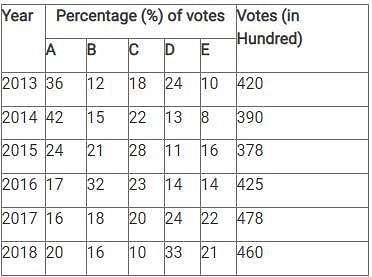
Q. What is the average number of votes a candidate gets in 2018?
Direction: Following table shows the percentage distribution of votes amongst five candidates A, B, C, D and E and total votes cast (in hundred) during the year 2013 to 2018 of collage presidential election. Study the data carefully and answer the questions based on it.
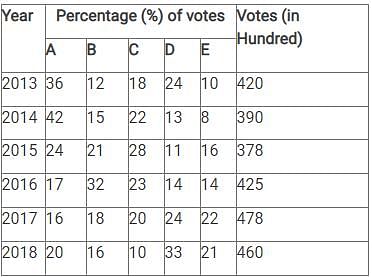
Q. If, out of the total number of voters in 2016 who fevered D, only 40 % could successfully cast their votes and remaining was unsuccessful. Find the number of voters who appeared to cast their votes in favour of D:
Directions: Study the given table and answer the following question.
The following table shows the number of students of 7 colleges participating in extra curricular activities:
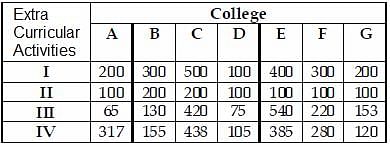
Q. Percentage of the number of students in activity II to that of IV is
Directions: Study the given table and answer the following question.
The following table shows the number of students of 7 colleges participating in extra curricular activities:
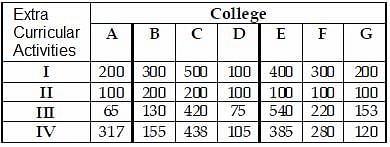
Q. The college in which minimum number of students participate in extra curricular activities is
Which of the following is not true regarding Renewable energy?
What will be the next number in the following series?
2, 5, 10, 17, 26, 37, 50, ?
In which year the world’s population growth is expected to be zero, as per the report published by United Nations?
The ratio of ages of two persons A and B is 3 : 4 and that of ages of B and C is 4 : 5. If the average of all three is 40 years, what is B's age?
Following are some statements regarding most of the web browsers. Choose the correct statements.
A. They have a home page
B. They do not have the ability to store users' favourite pages
C. They have hyperlinks to allow users to navigate
D. They do not keep a history of websites visited by the users
Choose the correct answer from the options given below :
A sum of money with compound interest becomes Rs. 2400 in one year and Rs. 3000 in two years. Find out the principal amount.
|
16 docs|120 tests
|


